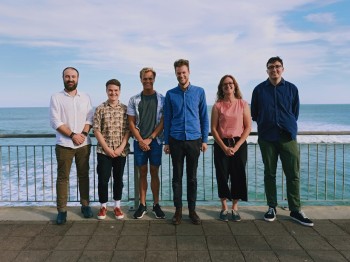The green hydrogen revolution
4 September, 2023

Members of the Garden group who are working on computational modelling of the hydrogen evolution reaction.
It holds the promise of virtually emissions-free energy - using electrolysers to split water (H₂O) into hydrogen (H₂) and oxygen (O₂), and using the resulting H₂ to power fuel cells in cars, buses, trucks and trains.
Our own government has recognised the potential of using our extensive renewable energy resources to create hydrogen for local industry and transport and even to become a hydrogen exporter.
There’s just one major problem. The catalysts used in the electrolysers that produce the hydrogen currently rely on expensive and rare metals such as platinum to operate efficiently. “Platinum sits in this Goldilocks zone,” explains MacDiarmid Institute Associate Investigator Dr Anna Garden, a lecturer in the Department of Chemistry at the University of Otago.
“To catalyse the conversion of protons and electrons into H₂, you need to bind the protons to the surface of the catalyst, which is where the reaction takes place. That forms hydrogen gas and then they leave again,” says Dr Garden.
A catalyst for change
Platinum-based catalysts facilitate that two-step process with great efficiency but fail the economic test to make ‘green hydrogen’ production viable. Dr Garden and her colleagues have spent the year exploring a potential alternative - molybdenum disulfide (MoS₂), a low cost inorganic compound with properties similar to platinum for hydrogen evolution.
“It’s been known to have some activity that’s useful for this reaction, but it’s not good enough yet,” says Dr Garden. Using computational modelling, she is able to determine what minute changes in the characteristics of MoS₂-based catalysts will mean for the efficiency of the process.
We are talking about a two-dimensional material that is just three atoms thick. The complicating factor when studying H₂ evolution over MoS₂ is that we are dealing with an electrochemical process. Its surface, the contacting electrolyte and the applied voltage all influence H₂ production rates. This adds complexity,
Dr Anna Garden Associate Investigator University of Otago
The computational models created by Dr Garden and her colleagues offer atomic-scale insights that can inform lab experiments using potential materials for catalysts. Along with MacDiarmid Institute student researchers at the University of Otago, Charlie Ruffman and Calum Gordon, and Professor Egill Skúlason from the University of Iceland, Dr Garden in June published a paper in the Journal of Physical Chemistry looking at the mechanisms for hydrogen evolution using MoS₂ catalysts.
Working through Covid
While the pandemic had disrupted research and the team’s plans to present their findings at the first Commonwealth Chemistry Congress which was to be held this year in Trinidad and Tobago, Dr Garden said a highlight of 2020 had been working with PhD student Charlie Ruffman.
“He’s really the driving force behind this research and he came through the year astonishingly well,” she says. The MacDiarmid Institute had moved early to support student researchers through lockdown by giving them a three-month extension for their research projects.
Work would continue next year on MoS₂-based catalysts, including modelling the impact of wrapping the materials into nanotube form.
“We are not putting all of our eggs in one basket and these catalysts aren’t any silver bullet, they won’t allow us to completely replace fossil fuels,” Dr Garden says.
“But they could help us create a more sustainable economy if we can get to that financial tipping point where the process of making hydrogen from electrolysis becomes competitive.”
At his lab at the University of Auckland, MacDiarmid Institute Principal Investigator Associate Professor Geoff Waterhouse experiments with those 2D materials, testing their performance for hydrogen production. The ground-breaking computational work of Dr. Garden’s group provides valuable insights and cues about the types of 2D materials we should synthesize for this application. His group takes bulk layered materials, then exfoliates these using chemical and electrochemical processes to give ‘2D nanosheets’.
Defects that deliver
“The 2D nanosheets expose numerous active sites for the hydrogen evolution reaction,” says Associate Professor Waterhouse. Defects on flat surfaces or at the edges of the 2D nanosheets are key to these materials being useful for the reaction.
Defects are very good for the adsorption of water and promote electron transfer processes, key steps in the efficient electrocatalytic production of hydrogen from water,
Associate Professor Geoff Waterhouse Principal Investigator University of Auckland
“We can also use ultrasonic treatments to introduce holes in the 2D nanosheets, thereby creating additional defects for enhanced performance.” Associate Professor Waterhouse’s group makes extensive use of X-ray based spectroscopies at the Australian Synchrotron based in Melbourne and similar facilities in Japan and China to examine the 2D nanosheet catalysts in detail.
The use of such techniques, together with high resolution electron microscopy techniques, allows his team to ‘visualise’ at the atomic scale, the working surface of active 2D electrocatalysts.
Another stream of work involves the development of 2D photocatalysts for hydrogen generation from water using direct sunlight.
“We could completely eliminate the electrical circuit altogether in H₂ production, simply by placing our semiconductor photocatalyst in water and exposing that system to sunlight,” explains Associate Professor Waterhouse.
For both electrocatalytic and photocatalytic H₂ generation, the key challenge is making these technologies efficient and adoptable at scale, thus allowing them to compete with conventional forms of hydrogen production based on fossil fuel feedstocks. Associate Professor Waterhouse normally spends four months of the year in China working with experts in the design and fabrication of 2D catalysts for hydrogen production, CO₂ reduction and N₂ fixation.
“We’ve lost basically one year of experimental work this year, due to the impact of Covid-19.” Just another reason to celebrate the emerging synergies between computational and experimental efforts to address CO₂ reduction within the MacDairmid Institute.


